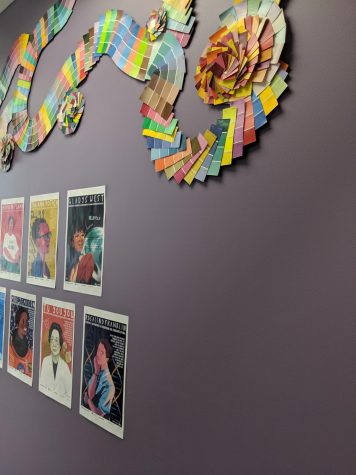Elementary Bike Program Promotes Health: Pedaling for Progress
It is raining, and Marjorie McClure is not pleased. Instead of the hillside outdoors, her second-grade physical education class troops into the great white tent serving as both cafeteria and gymnasium while Lafayette Elementary School is under construction.
Babbling amongst themselves, the students snap on matching blue helmets with nimble fingers. The bright blue scrub caps that they must wear underneath poof out around their heads and they look like miniature lunch ladies or doctors-in-training. Around a makeshift track in the makeshift gym, a handful of child-sized bicycles lie waiting.
Today is the final lesson. In less than a week this group of kids will go on a seven-mile bike trip through Rock Creek Park, the grand finale in the District of Columbia’s pilot Biking in the Park program.
“It’s a great opportunity,” McClure said later, after the class had gone and she was left cleaning up the various hula-hoops, rubber dots and bicycles. “It’s going to be very challenging and rigorous for them. But when they’re finished they are really going to feel good about themselves, because it’s quite an accomplishment.”
The grand idea to teach all second-graders in the District’s more than 70 public schools to ride bicycles came from a chance email from Daniel Hoagland, the education coordinator for the Washington Area Bicycle Association, to Miriam Kenyon, the city’s director of health and physical education. Hoagland suggested that the city remove all the tricycles used in pre-kindergarten classes in exchange for two-wheeled balance bicycles. Since part of his job entails providing bike safety and education programs to district schools, he saw firsthand how ineffective the tricycles were at preparing kids for real-world biking.
“As he goes around to schools, he sees kids in fifth grade that didn’t know how to ride,” said Kenyon, 42, her soft tone contrasting the severity of her tight ponytail and tall figure. “And I just couldn’t even believe that.” She herself learned at four years old, when her father perched her on top of a hill and simply let go. It was clear to her that something had to be done.
Hoagland provided the educational expertise. McClure wrote the curriculum. And Kenyon helped put it all together, seeking out funding and support. The result was 475 miniature bicycles, and the scene at Lafayette replicated in schools across the District: a swarm of small bodies navigating the controlled chaos of their biking lesson.
“Sometimes I get nervous,” said one girl seriously, taking her eyes off the classmate she was supposed to be observing. She was less confident than the others, and McClure still had to walk alongside when it was her turn to use the bike.
“After the first lesson my parents taught me,” interjected another.
Over the course of the forty-minute lesson, there were a few minor collisions, some teetering and tottering and toppling over. But the most important thing was that despite this, despite the rain and the cramped conditions, the kids were learning.
Putting the pedal to the metal
Within the past year, the chancellor of DC public schools initiated a plan intended to teach kids skills deemed essential cornerstones. For high school students, it was cardiopulmonary resuscitation (CPR) skills. For second graders, it was riding bicycles.
“We picked second grade because several kids may already know how to ride, and then some kids will not, but it’s a good age where it’s not embarrassing to not know how to ride and it’s not too late,” Kenyon explained.
To fund the program, she worked closely with Safe Routes to School coordinator Jennifer Hefferan. The federal government grants an allocation to cities and towns for its nationwide Safe Routes to School program in an effort to encourage children to walk and bike to school, simultaneously lowering consumption rates and battling childhood obesity.
According to Hefferan, initial funding for the program came from the money left over in the city’s budget, though in the coming years maintenance fees will be simply be built in.
Previously, Safe Routes developed bicycle education plans for schools, but now the cornerstone program will cover both education and technique. The biggest problem, Kenyon fears, will come after the four weeks of in-class training are up.
“The issues that I see are that kids in lower income areas don’t have access to bikes,” she said. “Bikes are expensive.”
And it’s no secret that certain parts of the city are more suited to biking than others. Wards 7 and 8 in particular lack essential resources.
“Obviously, from the District’s perspective, they want to give people the option to bike downtown, because that’s where the jobs are for the most part,” Hoagland, 37, said. “So the neighborhoods on the fringes tend to be a little bit left out in the cold.”
Officials at the District Department of Transportation are not unaware of this concern. In February, Mayor Muriel Bowser introduced a plan to improve the quality and safety of transportation across the city. Dubbed “Vision Zero,” it is a set of sweeping recommendations and policy changes aimed at making roads in the District safer for drivers, bikers, pedestrians and public transportation-takers alike.
“Sort of the whole idea behind Vision Zero is that the mayor asked us to tell her, ‘If I want to get to zero fatalities, what do I have to do?’” explained Jonathan Rogers, 32, a policy analyst for the District Department of Transportation.
The ambitious proposal seeks to end transportation-related casualties by 2024. In 2014, data from the Metropolitan Police Department show 23 fatalities, down from the 29 fatalities in 2013, but still on par with several cities with similar population sizes.
According to the Vision Zero website, some of the more than 20 different government agencies involved with the plan will develop strategies for improved biking conditions, considering not just safety but equity as well.
Using police data and an interactive “crowdsourcing” map where users can flag a street, intersection, or location that they think is dangerous, the analysts at the Department of Transportation examine the risk factors for crashes—number of bike lanes, speed limit and width of lanes—in order to determine high-priority areas.
“Obviously, from the District’s perspective, they want to give people the option to bike downtown because that’s where the jobs are, for the most part. So the neighborhoods on the fringes tend to be a little bit left out in the cold.”
“All those things contribute to our more severe crashes,” Rogers said. “And where our big arterial streets are, where our interstates, like 395 or 295 are, do kind of coincide with some of the lower income areas of the city.”
The interstates aren’t the only problem. An avid biker, Hoagland is familiar with the multitude of routes crisscrossing the city. He said certain routes have become more treacherous in recent years, leaving bikers facing unique challenges.
“It’s sort of the way the city is right now,” he said. “There’s large barriers—the river is one, the train tracks from Union Station going north are another, Rock Creek Park is a third. There’s large barriers and only a few ways across.”
Biking: the great divider
That’s not to imply that the District hasn’t already come a long way. Within the past decade and a half, the city has added nearly 57 miles of bike lanes, 3 miles of cycle tracks and 10 miles of multi-use trails, according to statistics gathered for MoveDC, a 20-year plan and precursor to Vision Zero designed to make the city’s transportation system more sustainable.
The catch, though, is that despite increased accommodations for bikers, much of the city’s focus has been on the more populous downtown area. For example, Rogers said that Capital Bikeshare stations tend to be clustered in the heart of the city, demonstrating “very obvious inequity.”
Part of this has to do with neighborhood culture. During the 2010 mayoral race, many residents in lower-income fringe neighborhoods voted against the incumbent, biking-enthusiast Adrian Fenty, fearing that he would cater to the wealthier half of the population by bringing in more bike lanes and stations.
However, the idea that people in these neighborhoods are against biking is “a complete misconception,” said Sterling Stone, 37, the executive director at Gearin’ Up, a nonprofit that sells and donates used bicycles.
“We see a lot of bikers, whether they be young or old, that are in these low income communities that bike just as much, if not more, than the affluent bikers in the city,” he said. For these people, the decision to bike is not usually born of a desire to be healthier or more environmentally conscious.
“Low income bikers need a bike to get to work, to get to school, to get to wherever they are going for whatever purpose and it’s a necessity, a need, it’s the only option other than walking,” he said. In 2010, the problem was not that people in lower-income neighborhoods were opposed to biking; according to Stone, it was that they perceived bike lanes and Bikeshare stations as “signs of gentrification.”
“They certainly do use bikes and they enjoy biking, but…I’ve had kids and families speak to us about the Bikeshare, and I’ve literally had people say, ‘Well, the Bikeshare is not for us,’” he said. “Meaning it’s for the white folks, the gentrifiers in the neighborhoods.”
To this day, biking resources and support are still lacking in these areas.
“There are zero bike shops in Wards 7 and 8,” Stone said. This is problematic, because bike shops often provide valuable safety and educational programs. Others, like Gearin’ Up, offer low-cost maintenance and repairs.
Rolling forward
The Washington Area Bicycle Association now offers its East of the River rider education program, bringing mobile bike shops to areas where support isn’t as strong.
“We just wanted to make sure these communities weren’t left behind,” Hoagland said. Educators from the bicycle association have also made an effort to train community leaders and provide resources to existing bikers; simultaneously, Gearin’ Up has tried to reach residents that haven’t been able to access those programs.
“We try to augment each other, not try to be in competition or anything, because there is so many people in need over there and not one organization can take that on,” Stone said.
Gearin’ Up is also committed to helping Biking in the Park succeed, pledging to host pop-up shops before the group rides so that the students can bring in their bikes for tune-ups. With the extra support, McClure is optimistic that the program will “put everyone on the same playing field.”
And Hoagland, whose email started it all, is also looking forward to long-term effects of the program.
“For students who already bike it’s just a chance to go out and have fun on a bicycle,” he said. “But for students who don’t already bike or don’t have access to a bike, it can be a real game-changer.”






